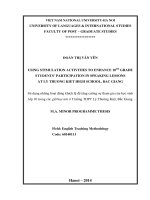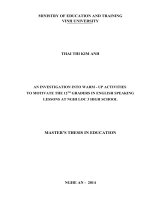The effectiveness of using information gap activities to promote grade 10 students’ participation in speaking lessons at Nguyen Dang Dao high school, Bac ninh province
Bạn đang xem bản rút gọn của tài liệu. Xem và tải ngay bản đầy đủ của tài liệu tại đây (153.3 KB, 7 trang )
The effectiveness of using information gap
activities to promote grade 10 students’
participation in speaking lessons at Nguyen
Dang Dao high school, Bac ninh province
Nguyễn Thị Hường
Trường Đại học Ngoại ngữ
Luận văn ThS. Chuyên ngành: English teaching methodology; Mã số: 60 14 10
Người hướng dẫn: Assoc.Prof.Dr. Nguyen Van Do
Năm bảo vệ: 2013
Abstract: This study is majorly aimed at investigating the effectiveness of using information gap
activities on grade 10th - students’ participation for at Nguyen Dang Dao High School, Bac
Ninh. In order to achieve this aim, the quasi- experimental research was carried out in 8 weeks
with classroom observation, students’ self report and interview as data collection instruments.
The sample of the study consisted of 90 grade 10th students from two intact classes. The
experimental group received the intervention of information gap activities in four speaking
lessons while the control one did not. The results indicated that experimental group’s
participation level increased significantly while the control group’s stayed almost the same.
Hopefully, this study can raise teachers’ awareness of using information gap activities in
teaching speaking to enhance learners’ involvement.
Keywords: Kỹ năng nói; Hoạt động điền thông tin; Phương pháp giảng dạy; Tiếng Anh
Content
PART A: INTRODUCTION
1. Rationale
This research is carried out for the following reasons: the increasing important role of English in
our present life, students’ weakness in speaking skill, the reality of learners’ poor participation
and the motivation created by imformation gap activities(IGA) in speaking lessons.
Firstly, it is undeniable that English has been playing a crucial role in our modern life. It is the
most effective means of global communication with a dramatic increase in number of users. It
also shows progressive effects in various aspects of life. Anyone, no matter where he lives, is
likely to be aware of the fact that having a good command of English helps him achieve the latest
information on science and technology. Therefore, it is English that enables him to improve his
study and work as well as betters his present life.
Secondly, Nguyen Dang Dao high school students seem to be worse at speaking skill than other
English skills whereas being good at it enables them to get a good job in the local region.
Nguyen Dang Dao high school is newly established and located in Tien Du district, where Tien
Son industrial Park is located with a variety of factories and companies, many of which require
employers’ good command of English. Young people in the local province have the priority to be
offered jobs provided that they can fulfill their requirements, one of which is English speaking
skill. However, most students in Bac Ninh, after graduating from high school and even a
university have difficulty speaking English in real situations.
In fact, learners’ poor participation is one of the factors responsible for their low speaking
proficiency. Most students at Nguyen Dang Dao School are reluctant to speak the target
language because of the lack of motivation. Many of them keep silent or chat in speaking lessons
while others make noise using their mother tongue. Therefore, language teachers should provide
their learners with continuous motivation to use English in class and the use of information gap
activities in speaking lessons is an excellent solution to improving the quality of students’
participation in oral lessons.
The application of information gap activities in English speaking lesson greatly encourages
students to use the target language in class in some ways. First, in this activity, one person has
certain information that must be shared with others in order to solve problem, gather information
or make decisions. This gives the students opportunity to speak English for an extended period of
time. In addition, speaking with peer is less intimidating than presenting in front of the entire
class and being evaluated. Another advantage of information gap activities is that students are
forced to negotiate meaning because they must take what they are saying comprehensible to
others in order to accomplish the task. Therefore, information gap activities are of great use in
English speaking lessons. Making full use of these activities will definitely result in successful
speaking lessons.
The aforementioned reasons have urged the researcher to conduct the study entitled “The
effectiveness of using information gap activities to promote grade 10 students’ participation in
speaking lessons at Nguyen Dang Dao high school, Bac Ninh province”. It is hoped that the
research will provide a better view to the effectiveness of these activities on students’
participation in speaking lessons.
2. Purpose and significance of the study
The study aims at:
+ investigating the effectiveness of using information gap activities on students’
participation level in English speaking lessons.
+ Raising language teachers’ awareness of exploiting these activities.
The study can be beneficial to both students and teachers. First, it enables teachers to confirm the
importance of information gap activities in teaching speaking skills. Hence it promotes teachers’
using of these activities in class, which creates a natural and highly motivational environment
for students to speak the target language to their partners.
3. Research Questions
In order to achieve the above- mentioned purposes, the following research questions were
formulated and needed to be answered:
1. Does the implementation of information gap activities really increase grade 10 students’
participation in speaking lessons at Nguyen Dang Dao high school?
2. What are students and teachers’ attitudes towards IGA?
4. Method of the study
The study was carried out using quasi- experimental research method with the use of classroom
observation, questionnaires students’ self- reports, and interviews as data collection instruments.
Two intact classes were samples of the study. Forty five students from class 10A5 were chosen
for the control group while the same number of students from class 10A6 was the experimental
group that receives the treatment of IGA. To collect data for the study, classroom observations
were conducted together with students’ self reports and interviews to confirm the information
from observers. All the comments, remarks, recommendation and conclusions presented in the
thesis were based on the analysis of the study.
5. Scope of the study
There are various activities for teachers to promote students’ participation in classroom
activities. However, within the limitation of research time and the allowed length of a minor
research, this study only focuses on exploring the effectiveness of information gap activities on
10 grade students’ participation in speaking lessons at Nguyen Dang Dao High School, Bac
Ninh.
6. Overview of the thesis
This study consists of three main parts: Introduction, Development and Conclusion.
Part A: Introduction.
The introduction part briefly presents the rationale of the study, the aims, research questions,
methods, scope, the significance and the overview of the study
Part B: Development
The development part consists of three chapters.
Chapter one provides essential literature review relevant to the study including teaching
speaking, IGA, students’ participation.
Chapter two presents the methodology underlying the research. It deals with the research
method, the participants of the study, the variables, the intervention, the instruments and
procedure for data collection.
Chapter three is devoted to presenting how data was analyzed, what are the findings of the
study and the discussions about the study results.
Part C: The thesis ends with the conclusion and recommendation part which gives a summary of
the main issues that have been discussed, the limitations of the study, some recommendations
and suggestions for further research as well.
REFERENCES
Bailey,K. M (2005). Practical English Language teaching: Speaking:McGraw- Hill
Companies,Inc
Barry, K. (1993). Beginning Teaching (2
nd
ed). Wentworth Falls: Social Science Press.
Brown, G & Yule,G (1991)Teaching Spoken Language. Cambridge: Cambridge.
Byrne, D (1998) Teaching Oral English. New York: Longman
Cathart, R. (1986). Situational Differences and the Sampling of Young Children’s Classes,
Heinle & Heinle
Chaney, A.L.B , & Burk, T.L (1998). Teaching Oral Communication. Boston: Allyn
&Bacon.
Ellis, R (1985). Understanding Second language acquisition. Oxford: Oxford University Press
Ellis, R (2003). Task-based Language Learning and Teaching. Oxford: Oxford University Press
Farzi,N.Y . Classroom participation: A Case Study of a Junior High School Students
/>FAZRI_NUR_YUSUF/Kumpulan_artikel
ppt/Paper_CONAPLIN_Participation_Fazri%26Intan.pdf
Hammer, J (1999). The Practice of Language Teaching. Malaysia: Longman.
Harmer, J. (1993). The Practice of English Language Teaching. London: Longman.
Harmer.J (2002) . How to Teach English. Malaysia. Longman.
Hoang Van Van (2007), Tieng Anh 10, Education Publishing House.
Hopkins, D. (1985). A Teacher’s Guide to Classroom Research. Milton Keynes: Open
University Press.
House, J. (1986). Learning to Talk: Talking to Learn. An Investigation of Learners Performance
in Two Types of Discourse. Kasper.
Kayi, H (2006). Teaching Speaking: Activities to promote Speaking Skills in a SecondLanguage
“. The Internet TESL Journal, Vol.XII, No 11, November 2006.
Lawtie, F. (2004) .Teaching Speaking Skills to Overcoming Classroom Problems.
Le Phuoc Ky (2002). Problems, Solutions, and Advantages of Large Classes. Teacher’s Edition,
9(9), 8-11.
Lightbown,P.M, & Spada, N (1999). How Languages are learned. Oxford: Oxford University
Press
Littlewood,W (1991). Communicative Language Teaching. Cambridge: Cambridge.
Mortensen (2008). Instructions &Participation in the Second Language Classroom.
University of Denmark.
Neu,H & Reeser, T.W. (1997) . Information Gap Activities for Beginning French
Nunan, D (1999). Second Language Teaching and Learning. Canada: Heinle & Heinle
Nunan, D(2003). The Impact of English as a Global Language on Education, Oxford University
Press.
Nunan, D. (1998). Language Teaching Methodology. London: Prentice Hall. Oxford University
Press.
Pattison, P. (1989).Pupil Motivation and Oral Communication Skills. ELT Journal Vol. 51,
No.2.TESOL Quarterly, 37(4), 589-613.
Prabhu, N .S (1987). Second Language Pedagogy. Oxford: Oxford University Press.
Raptou, V (2012). Using Information Gap Activities in the Second Language Classroom.
Retrieved December4, 2010 from .
Tran Lam Son .(2009). Information Gap Activities to promote communication in EFL
www.britishcouncil.org/tram_lam_son.doc
Tsui , A(1996), Reticence and Anxiety in Second Language Learning
Turner, J. C., & Patrick, H. (2004). Motivational Influences on Student Participation
Ur. P (1996). A Course in Language Teaching. Cambridge University Press, Cambridge
Weimer.M (2011). 10 Benefits of Getting Students to Participate in Classroom
/>participate-in-classroom-discussions/









